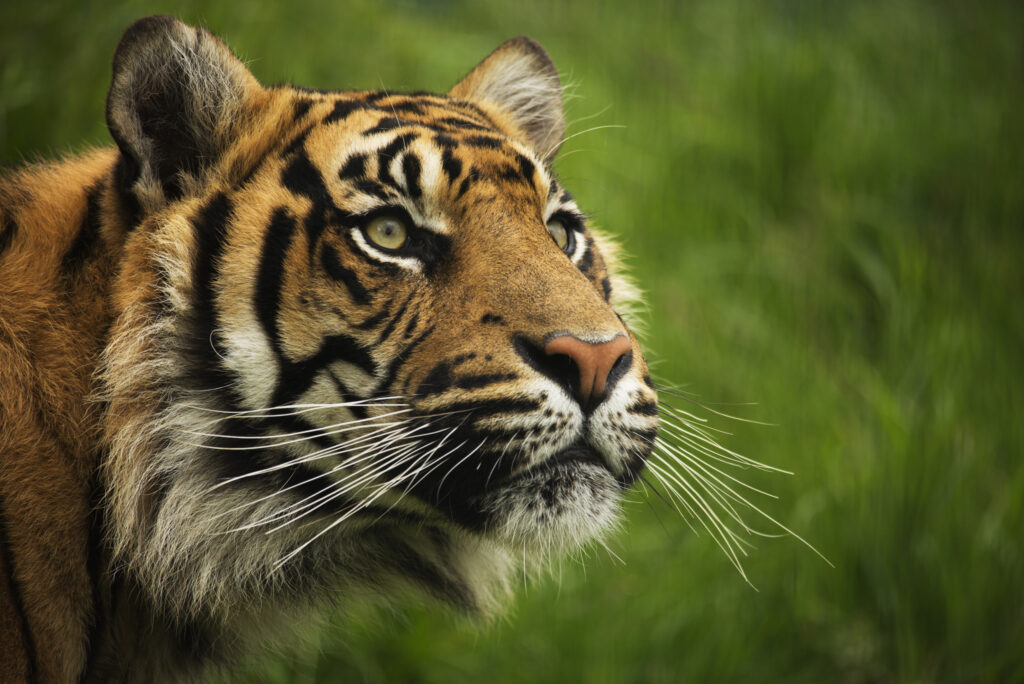Magnificent yet rapidly vulnerable, the Sunda tiger is the last surviving tiger species in Indonesia’s the Sunda Islands after the Javan and Bali tigers were hunted to extinction.
Presently, they stay only in Sumatra’s dense forests and are usually called Sumatran tigers. Scroll on to discover more about their life, diet, and habitat, as well as a few extraordinary Sunda tiger facts.
Sunda Island Tiger: Things To Know
About Sunda Tigers :
Common Name : Sumatran tiger
Scientific Name : Panthera tigris sumatrae
Type : Mammals
Diet : Carnivore
Average Lifespan : 15 to 20 years
Size : Up to eight feet

How Long do Sunda Tigers Live and How Big are they ?
The Sumatran or Sunda tiger is among the smallest species of tiger. Male sizes are approximately 2.3m long and weigh up to 140kg, and females are a little smaller, weighing about 110kg and averaging about 2.1m long.
Their fur manages to be darker and the black stripes are much thicker and nearer together than their continental cousins. Among the most fascinating facts about Sunda, tigers are that they’ve noticeable beards and lots of fur around their faces.
Like other tigers in the woods, Sunda tigers can live for about 15 to 18 years. In captivity, they often live slightly more– up to about 20 years or more – and the oldest noted Sunda tiger survived to the ripe old age of 26.
Sunda Tigers Lifespan
A century ago, the Sunda Islands were home to thousands of tigers. Currently, they can only be seen on Sumatra island, from the Gunung Leuser National Park’s dense mountainous forests in the north to Bukit Barisan Selatan National Park on the southern tip of the island.
It’s thought that the biggest population of these species is in the Kerinci Seblat National Park on the island’s west, where there can be as many as 190 individuals.
In around 1985, there were around 800 tigers on the island. However, by 1992 that number had dropped to about 500 to 600.
Currently, the most recent calculations put the entire number of Sumatran or Sunda tigers at no more than 400, and there are a few conservative estimates that indicate there might be as low as 250 left in the wildlife.
There are protection actions in place, though it’s feared that the rate of fatal habitat destruction, deforestation, and forbidden poaching is outrunning the incredible work the conservationists are accomplishing.
For an instance, between 1985 to 2014, the island’s forest cover decreased from 58 percent to only 26 percent.
Therefore, there is a true fear that the Sunda tiger might be the 21st century’s first big cat extinction.
Sunda Island Tiger Diet :
Like every species of tiger, the Sunda tiger is an obligate carnivore and an apex predator, meaning they’re naturally dependent on a meat diet.
Their major sources of prey are macaque monkeys, fish, wild pigs, tapirs, deer, porcupines, and occasionally crocodiles, too.
Not unlike their mainland cousins, only about 10% of their hunts are successful – so they’ll fill as much as possible when eating. It’s considered that at one time they can feed as much as 35 kg of meat. That’s equal to about 80 portions of chips and fish!

Sunda Tiger Facts A Separate Subspecies
Among the most exciting Sumatran tiger facts is that it’s among the two subspecies of tiger.
The first, Panthera Tigris includes the Malayan, Bengal, South China, Siberian, and Indochinese tiger populations, and the 2nd, Panthera tigris sondaica only comprises the Sumatran or Sunda tiger. It did contain the Javan and Balinese tigers but unfortunately, both are now extinct.
Whiskers in the Wind
If you have ever wished to know the amazing facts about the Sunda tiger’s whiskers, your wait is over. They are thick, extremely sensitive, and linked to their nervous system.
They can catch small alterations in the wind and air and they offer quite proper information about the tiger’s locations, including the probable location of food.
They can also – pretty remarkably – aid to evaluate the length between two points and they help tigers in discovering paths through narrow and small spaces, even at night.
The World’s Friendliest Tiger ?
Tigers are popularly solitary creatures and Sunda tigers generally exist in a fairly isolated existence. However, among the most captivating Sunda tiger facts is that they have been known to pleasantly share meals with tigers from neighboring families when food is deficient.
The Difference is Genetics
There was a period when nearly every tiger had an identical genetic makeup. Yet between 6,000 to 12,000 years ago, the Sunda Island tiger’s ancestors were cut off from mainland tigers because of rising sea levels.
They went on to create their hereditary blueprint. This is why currently they are classified as a different subspecies to the Malayan, Indochinese, Bengal, Siberian, and South China tigers.
Threats
Poaching and Habitat loss are the two major threats the severely threatened Sumatran tiger faces.
The oil palm plantations expansion was the primary reason behind a around 20% loss in Sunda tiger habitat from 2000 to 2012, one analysis found. Prey animal loss due to deforestation is also having an adverse consequence on Sumatran tigers.
Tiger poaching happens even in secure regions. Tiger bones are utilized to produce tiger bone wine, a liquor in demand by a few rich Chinese who think it’ll impart the traits of the tiger to the drinker.
FAQS
How many Sunda tigers are left?
Sumatran tigers are characterized by hefty black stripes on their orange skins. The last of the Sunda island tigers—calculated to be less than 400 presently—are holding on for survival in the remaining forest patches on Sumatra island.
What’s the rarest tiger?
Sunda or Sumatran tigers are the smallest and rarest species of tiger worldwide and are presently indexed as severely endangered. Tigers are both great climbers and swimmers with strong muscular builds and enormous claws. To capture prey, they chase alone.
Which are the three extinct tigers?
These include the Bali tiger (Pantera Tigris balica), the Caspian tiger (Panthera tigris virgata), and the Javan tiger (Panthera tigris sondaica). These tiger species have not been seen for decades and none are in captivity.



